ABSTRACT
Brazil seeks to optimize the use of fertilizers by taking advantage of agricultural residues. The sewage sludge is used as organic matter in various crops such as coffee. However, an experiment in lysimeter was performed seeking to assess the growth, yield and content of zinc, copper, nickel, cadmium, lead and chromium in coffee fruits grown on Dystrophic Red Yellow Latosol (dRYL), Dystropherric Red Latosol (dRL) and Dystrophic Red Yellow Argisoil (dRYA); under successive application of sewage sludge. The sewage sludge increased the content of Cd, Cr, Cu, Pb and Zn found in soils under study. The sewage sludge decreased coffee growth and productivity and increased the content of Cu, Zn and Cd found in coffee peel. Greater content of Cd in coffee seeds for all three soils, as well as greater content of Zn and Pb in coffee seeds grown on Dystropherric Red Latosol was also found.
Key words: Coffea arabica, coffee plants height, quality of coffee fruit, heavy metals.
To recycle organic residues in farming is the basic condition for increasing sustainability in agricultural systems, because it allows possibilities of using nutrients, energy, organic matter, and avoid pollution of essential matrices such as water, used for food production (Chen and Jiang, 2014). The urban population growth is the greatest source of various residues, which are often accumulated in the environment without adequate treatment or use that allows its recycling. The sewage sludge, a semisolid residue, is highlighted among those residues, with considerable percentage of organic matter and essential elements for plants (Berton and Nogueira, 2010). This residue, when adequately hygienised and dry, can be used as organic fertilizer and can be incorporated into the soil as source of nutrients for plants (Bettiol and Camargo, 2006).
Although the agricultural use of sewage sludge is considered the most promising alternative of its final disposal (Campos and Alves, 2008), the presence of heavy metals may limit its use. Thus, the recycling of nutrients contained in sewage sludge may be by means of its use in agricultural areas, since the residue is within the minimum standards required by environmental agencies in relation to presence of heavy metals and human pathogens, among others (Bettiol and Camargo, 2001; Brasil, 2006).
The accumulation of heavy metals in soils is the major concern regarding the environmental safety (Soares et al., 2005); because these elements may express their polluting potential directly on soil organisms by means of their availability to plants in phytotoxic levels, besides their transfer possibility into the food chain by means of plants or through contamination of surface and subsurface water (Chang et al., 1984).
Therefore, considering that Brazil is a greater producing and consuming country of coffee in the world, we performed this research aiming to assess the growth, yield and content of zinc, copper, nickel, cadmium, lead and chromium found in coffee fruits grown on Dystrophic Red Yellow Latosol, Dystropherric Red Latosol, and Dystrophic Red Yellow Argisoil; under successive application of sewage sludge.
The experiment was performed between the year of 2009 and 2013 in a set of 36 drainage lysimeters with 0.9 m deep and 1 m diameter. Lysimeters contain material with undisturbed structure of Dystrophic Red Yellow Latosol (dRYL), Dystropherric Red Latosol (dRL), and Dystrophic Red Yellow Argisoil (dRYA). The soil granulometry in the layer from 0 to 20 cm was estimated using the pipette-based method (Donagema et al., 2011), and the contents of clay, silt and sand were respectively 592, 48 and 360 g kg-1 for dRYL; 677, 91 and 232 g kg-1 for dRL; and 330, 203 and 467 g kg-1 for dRYA.
Bean and corn were cropped at the experimental area (column) before planting coffee seedlings. The bean was planted in late June and harvested in late October, 2009. The corn was planted in late November, 2009 and harvested in late March, 2010. The planting of coffee seedlings was in late December 2009, before harvesting corn, seeking to reduce the light intensity on coffee seedlings.
Soil samples were collected at the layer from 0 to 20 cm, before planting bean, seeking to estimate contents of Cu and Zn by means of the Mehlich-1 extractor. The study found respectively 1.5 and 4.0 mg dm-3 for dRYL; 2.7 and 4.8 mg dm-3 for dRL; and 0.7 and 4.2 mg dm-3 for dRYA. By using the same extraction method, contents of Cd, Pb and Cr were also estimated, which were found to be less than the detection limit, <0.01 mg.dm-3 (Silva, 2009).
Liming and corrective phosphate fertilization were carried out based on results of chemical analysis carried out in 15 April, 2009 and 8 May, 2009 in all lysimeters. The amount of lime was estimated by means of bases saturation method to elevate them to 70%. Thus, the adding quantities of chalky (36% of CaO, 14% of MgO and total reactive potential of neutralization equal to 95%) were about 1.6, 2.6 and 5.7 Mg ha-1 respectively for dRYL, dRL and dRYA. The amount of phosphorus added to the soil was about 2.0 Mg ha-1 P2O5, used as single superphosphate. The second liming was at 21 November, 2011, and quantities of lime were 2.7, 3.3 and 0.5 Mg ha-1, respectively for dRYL, dRL and dRYL.
Doses of sewage sludge were estimated according to the content of total nitrogen (N), ammonium (NH4+) and nitrate (NO3-) present in the sludge, as well as the nitrogen required for coffee trees. The D3 dose corresponded to the requirement in total nitrogen for the crop, and the doses D0, D1 and D2 were 0, ¼ and ½ of D3, respectively. The sewage sludge was applied for four times. The first application was about seven months before plantation of coffee seedlings (Coffea arabica L. cv. Mundo Novo 379/19) at doses about 0, 11, 22 and 44 Mg ha-1. The second application was four months after plantation at doses about 0, 8, 16 and 32 Mg ha-1; and the third and fourth applications were done respectively at the first and second year after plantation at doses about 0, 15, 31 and 61 Mg ha-1. Then, applications of sewage sludge were in 15 May, 2009, 16 April, 2010, 14 April, 2011, and 28 April, 2012, respectively.
The sewage sludge was distributed on the whole soil surface of each column, and incorporated at the first 10 cm deep, avoiding the soil revolving for the deepest layers. Considering the content of N found in the sludge and 28% of mineralization rate - in kg ha-1 - in the first year after application (Chiaradia et al., 2009), the amount of N potentially mineralized in a year is equivalent to 6.26 × dose of sewage sludge in Mg ha-1. The amount of K2O provided by the sewage sludge in kg ha-1 is equal to 4.23 × dose of sewage sludge in Mg ha-1.
The sewage sludge was obtained from the Jundiaí Treatment Station, State of São Paulo, which predominantly receives domestic sludges. This material passed through the composting process for about 90 days. The content of metals in the sewage sludge was estimated by means of the 3051A method (United States Environmental Protection Agency - USEPA, 1998), and results are shown in the Table 1.
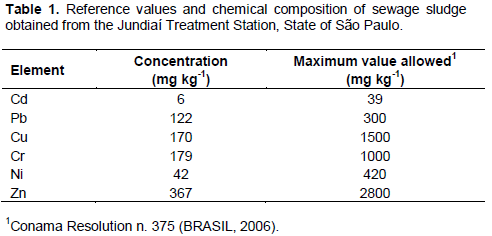
The ammonium sulphate was added to each lysimeter during the first application of sewage sludge and about four months after, at doses about 188 and 97 kg ha-1. The potassium chloride was also added to each lysimeter during the first application, according to doses of sewage sludge as follows: 177, 132, 87 and 0 kg ha-1 for doses 0, 11, 22 and 44 Mg ha-1. Five months after the first application of sewage sludge, the ammonium sulphate was added according to doses of sewage sludge as follows: 570, 430, 145 and 0 kg ha-1, respectively for doses 0, 11, 22 and 44 Mg ha-1. The potassium chloride was also added to the lysimeter during the same season, at the dose about 69 kg ha-1. During the third and fourth applications of sewage sludge, the ammonium sulphate was added according to doses of sewage sludge as follows: 1.819, 1.364, 909 and 0 kg ha-1, respectively for doses 0, 15, 31 and 61 Mg ha-1. The potassium chloride was also added to each lysimeter according to doses of sewage sludge as follows: 670, 556, 442 and 214 kg ha-1, respectively for doses of 0, 15, 31 and 61 Mg ha-1.
Samples of soil were collected in 16 December, 2013 on the layer from 0 to 10 cm. These samples were used to estimate contents of Cd, Cu, Pb, Cr and Zn by means of Mehlich 1 extractor (Silva, 2009). The height, stem diameter and number of plagiotropic branches were measured monthly for plants growth assessment from January 2011 to July 2012. Coffee fruits were hand harvested from May to August 2012 and, then, dried in the hothouse at 60°C until obtaining about 11% of humidity. Fruits were mechanically peeled using simple manual peeler. The removal of peels from grains was made using a simple automatic blower. Peels were milled on a Willey type mill, and grains were milled in an analytical coffee-mill model A11, brand IKA, using liquid nitrogen.
A sample about 0.5 g was placed in a Teflon tube and 5 mL of nitric acid (HNO3) was added. Then, tubes were hermetically sealed to allow digestion according to the method 3051A (USEPA, 1998). This method allows digestion of samples with HNO3, under high pressure (65 pi) and high temperature (180°C), for 10 min. After digestion, the extract was filtered and the volume filled until 10 mL using distilled water. From these extracts, contents of Cu and Zn were estimated by means of atomic absorbance spectrometry in air-acetylene flame. Contents of Cr, Ni, Cd and Pb in graphite furnace were also estimated. The AAnalyst 800 equipment of Perkin Elmer was used.
The control and results quality guarantee were ensured by using Plankton BCR-414 reference material, certified for vegetable matrix analysis in each samples group analysis, as well as blank samples. Results were satisfactory, with recovery about 114% for Cd, 61% for Cr, 58% for Ni, 70% for Pb, 111% for Cu and 112% for Zn. The metal detection limits were also estimated and, the following values were obtained: Cd = 0.24 µg kg-1, Cr = 2.13 µg kg-1, Ni = 3.37 µg kg-1, Pb = 2.31 µg kg-1, Zn = 0.03 mg kg-1 and Cu = 0.09 mg kg-1.
Statistical analysis
The effect of soils and doses of sewage sludge for each soil was analyzed using the first and second degrees polynomial regressions. The experiment was performed in randomized complete block design. Contents of Cd, Cr, Cu, Pb and Zn were subjected to analysis of variance using the F test. Standardized results of trace elements were subjected to principal component analysis, seeking to analyze the effect of soils, doses of sewage sludge and interrelations between variables. Seeking to represent results, the scores and loadings were used to organize soils and doses of sewage sludge in a bidimensional plane. All analyses were carried out using the R Statistical Software (R Development Core Team, 2014), running the arm and ggplot2 packages.
The principal components analysis allowed to explain 80.4% of total variance of data about soil metals on the first two components. The first component contributed about 58.4% of total variance, and the second with 22% (Figure 1). There was dissociation of doses of sewage sludge in the component 1, which allowed to understand the pattern of dissimilarity gradient. This gradient was increased as doses of residue increased. Averages of positions of centroids of doses of sewage sludge, namely, D0, D1, D2 and D3 were, respectively 2.13, 0.49, -1.34 and -1.43 in the component 1. In addition, it was also possible to understand the grouping of dRYL and dRYA, which were dissociated from dRL. Averages of positions of centroids for dRYL, dRYA and dRYL in the component 1 were, respectively 0.39, 0.27 and -0.63; showing that the soil dRL was the most affected by doses of sewage sludge. Regarding the component 2, the dRYL and dRL were dissociated from dRYA, with averages of positions of centroids equals to 0.81, 0.28 and -1.03 for dRYA, dRL and dRYL, respectively.
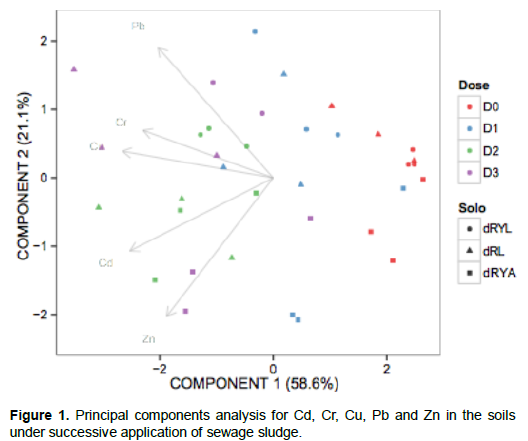
The structure of principal components analysis, which indicates a correlation between original variables and components 1 and 2, is represented by the direction, orientation and length of arrows shown on the biplot. Then, it is possible to see that contents of Cd, Cr, Cu, Pb and Zn were increased as doses of sewage sludge increased. Besides, contents of Cd, Cr, Cu, Pb and Zn were lesser than the reference values established in the context of preventing contamination (Brasil, 2009) (Table 2). The height, stem diameter and number of coffee plagiotropic branches showed statistical differences between soils and between doses of sewage sludge within each soil from 1 and 499 days (Table 3).The height, diameter of stem and number of coffee plagiotropic branches did not show statistical differences between soils for the treatment without sewage sludge (Figure 2). The coffee height grown on soils dRYA and dRL reduced significantly with applying sewage sludge, however, causing no effect on dRYL. The stem diameter of coffee grown on dRL and dRYL increased with applying sewage sludge. However, there was no effect of doses of sewage sludge for coffee grown on dRYA soil. Besides, there was positive and significant effect for coefficient that correlated doses of sewage sludge and stem diameter for dRL and dRYL. The number of coffee plagiotropic branches grown on dRYA and dRL decreased with applying sewage sludge, but they increased on dRYL.
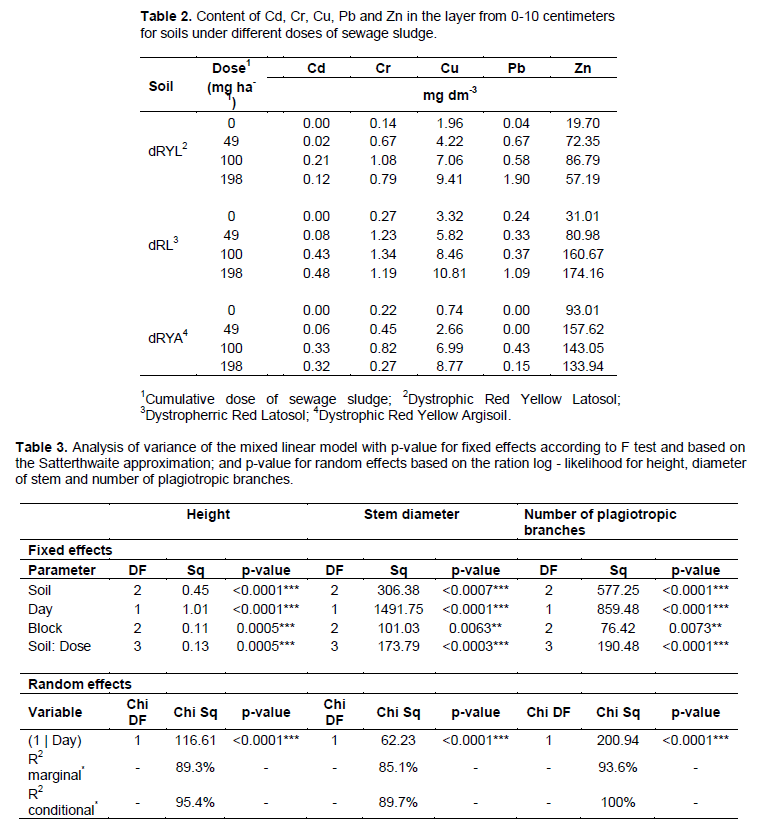
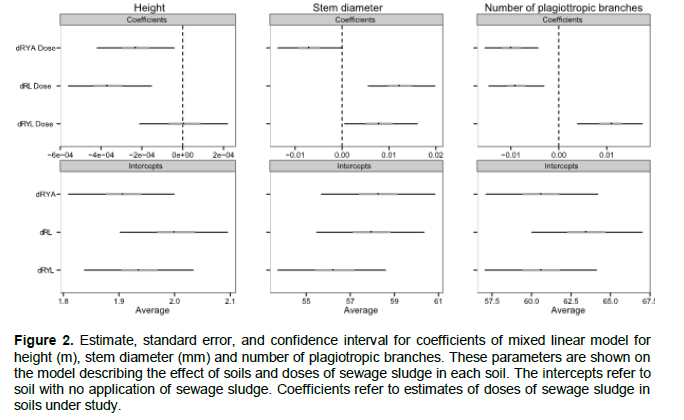
The coffee productivity was significantly different in studied soils (F2,28 = 5.38 and p-value = 0.0107), and for doses of sewage sludge in each soil (F3,28 = 18.6 and p-value < 0.0001). In addition, the productivity was lesser on dRYL (0.77 kg plant-1) when compared to dRL and dRYA (0.95 and 1.11 kg plant-1, respectively). Martins (2003), studying the coffee productivity (variety Acaiá IAC-474) with about 10 years, on Eutropherric Red Latosol, found similar results in terms of fruit yield, about 1.0 kg plant-1. Catani et al. (1967) found fruit yield about 1.2 kg plant-1 for Mundo Novo variety with about 10 years on Red Latosol. The fruit yield reduction found with application of sewage sludge in this study was slight on Drl and evident on dRYA (Figure 3). Martins (2003) found coffee fruit yield about 0.62 and 0.59 kg plant-1 for Acaiá IAC-474 variety with about 9 and 6 years. This variety was grown on Dystrophic Red Latosol and Dystrophic Red Argisoil; with cumulative doses of sewage sludge respectively about 29.8 and 18 Mg ha-1, dry basis.
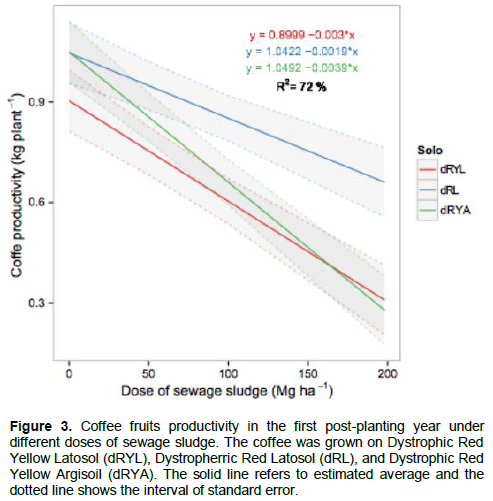
The amount of Cu found in coffee peel was statistically different in studied soils (F2,28 = 16.69 and p-value < 0.0001), as well as for doses of sewage sludge in each soil (F3,28 = 34.66 and p-value < 0.0001). The content of Cu coffee peel grown in soils without sewage sludge was as follows: dRYA (7.7 mg kg-1) < dRL (10.9 mg kg-1) < dRYL (12.5 mg kg-1) (Figure 4 and Table 4). Martins (2003) found similar amount of Cu of coffee peel, about 14.6 mg kg-1, for coffee grown on Eutropherric Red Latosol without application of sewage sludge. Malavolta et al. (1963) found the highest content of Cu in coffee peel (18 mg kg-1) for varieties Mundo Novo, Caturra Amarelo and Bourbon Amarelo grown on Red Latosol.
The amount of Cu found in coffee seeds was not statistically different in studied soils (F2,28 = 1.42 and p-value = 0.26), as well as for doses of sewage sludge in each soil (F3,28 = 1.89 and p-value = 0.15). The content of this element in coffee seeds did not change according to type of soil and doses of sewage sludge (Figure 4). The content of Cu in coffee seeds was about 13.1 mg kg-1 (Table 4). Similar results were obtained by Martins (2003), which did also not found differences between doses of sewage sludge (the content of Cu in coffee seed was 14.6 mg kg-1). Malavolta et al. (1963) found similar amount of Cu in coffee seed of three different varieties (15 mg kg-1).

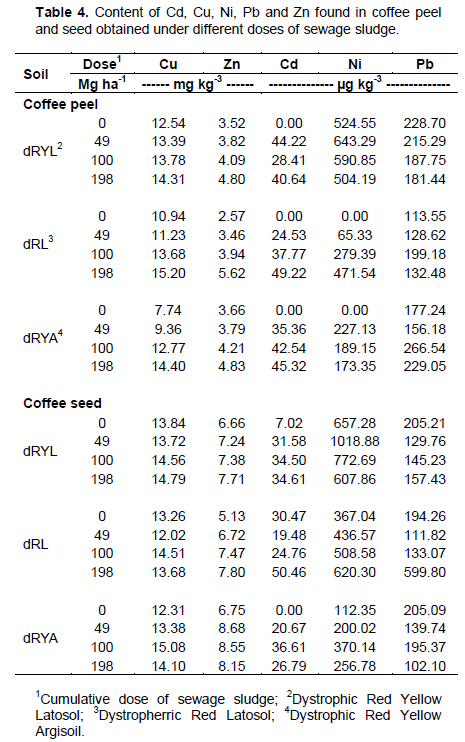
The amount of Zn found in coffee peel did not show statistical differences in studied soils (F2,28 = 0.63 and p-value = 0.54). However, it was changed by doses of sewage sludge in each soil (F3,28 = 25.37 and p-value <0.0001). The amount of Zn found in coffee peel grown on soils with no sewage sludge was 3.1 mg kg-1 (Table 4). Martins (2003) found content of Zn greater in the peel (6.4 mg kg-1) for coffee grown on Eutropherric Red Latosol with no sewage sludge. However, this result differs to that obtained in Malavolta et al. (1963), which reported contents of Zn about 10 times higher (70 mg kg-1) in coffee peel of three varieties.
The amount of Zn found in coffee peel increased with the increase of doses of sewage sludge in the studied soils. This effect was most expressive on dRL in relation to others (Figure 5). Concentrations of Zn obtained on dRL were around 2.6 and 5.6 mg kg-1 respectively for lesser and greater doses of sewage sludge (Table 4). Martins (2003) found content of Zn in coffee peel about 5.6 mg kg-1 for Acaiá IAC-474 variety with 9 years. This variety was grown on Dystrophic Red Latosol, with cumulative doses of sewage sludge about 29.8 Mg ha-1, dry basis.
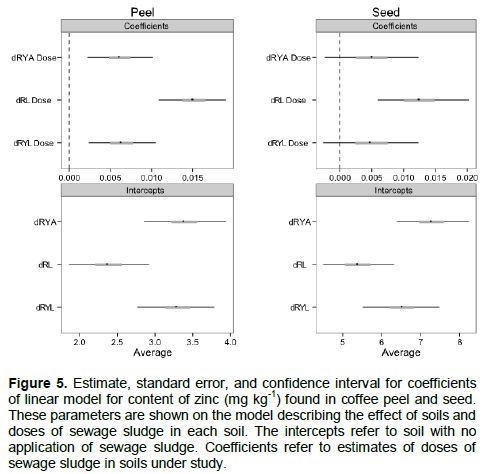
The amount of Zn found in coffee seed was statistically different in studied soils (F2,28 = 5.75 and p-value = 0.008) and was changed with application of different doses of sewage sludge in each soil (F3,28 = 5.29 and p-value = 0.005). The content of Zn found in coffee seed grown on soils with no sewage sludge was 5.1, 6.7 and 6.8 mg.kg-1 respectively for dRL, dRYL and dRYA (Table 4). Martins (2003) found similar content of Zn in coffee seeds, about 6.9 mg kg-1, for coffee grown on Eutropherric Red Latosol without sewage sludge. However, these results differ from those reported by Malavolta et al. (1963), which found the highest values of Zn (12 mg kg-1) in coffee seed for three varieties.
The content of Zn in coffee seed was increased with increasing of doses of sewage sludge on dRL. Concentrations of Zn in coffee seeds from this soil were around 5.1 and 7.8 mg kg-1, respectively for lesser and greater dose of sewage sludge (Table 4). Martins (2003) reported content of Zn in coffee seeds about 6.6 mg kg-1. This content was found in Acaiá IAC-474 varieties with about 9 years, grown on Dystrophic Red Latosol; with cumulative dose of sewage sludge about 29.8 Mg ha-1, dry basis.
The amount of Cd found in coffee peel and seed did not differ statistically in the studied soils (F2,25 = 0.17 and 2.29, and p-value = 0.8446 and 0.1225 respectively for peel and seed). However, it differed significantly for doses of sewage sludge in each soil (F3,25 = 9.56 and 6.28, and p-value < 0.0001 respectively for peel and seed). The amount of Cd found in coffee peel and seed increased with application of sewage sludge (Figure 6). Concentrations of Cd obtained in the greater dose of sewage sludge resulted in 49.2 and 50.5 µg kg-1 of Cd respectively in the peel and seed (Table 4). Martins (2003) found content of Cd about 0 and 70 µg kg-1 in coffee peel, and 70 and 30 µg kg-1 in coffee seed. These were obtained from Acaiá IAC-474 varieties with 9 and 6 years, grown on Dystrophic Red Latosol and Dystrophic Red Argisoil, with cumulative doses of sewage sludge, respectively about 29.8 and 18 Mg ha-1.
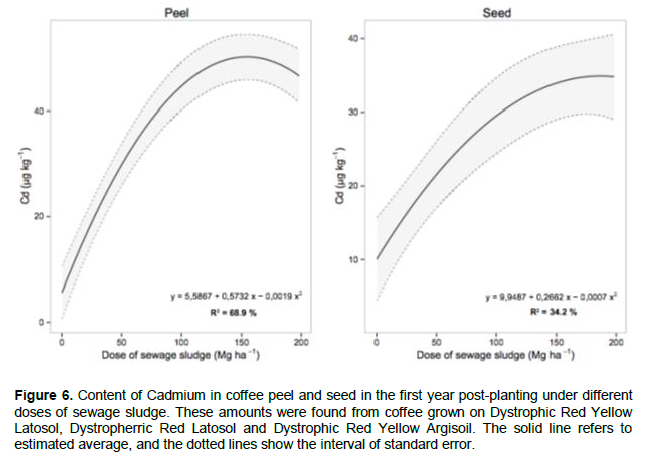
The amount of Ni found in coffee peel and seed was significantly different in studied soils (F2,28 = 44.39 and p-value < 0.0001), as well as for doses of sewage sludge in each soil (F3,28 = 10.31 and p-value <0.0001). The amount of Ni found in peel from coffee grown on soils without sewage sludge were 0 for dRL and dRYA, and 0.5 mg kg-1 for dRYL (Table 4). Martins (2003) found similar amount of Ni in coffee peel, about 0.2 mg kg-1, obtained from coffee grown on Eutropherric Red Latosol without sewage sludge.
The content of Ni found in coffee peel, obtained from coffee grown on dRL, increased with application of sewage sludge. In addition, it was not affected on dRYL and dRYA (Figure 7). Concentrations of Ni obtained in this soil were around 0 and 0.4 mg kg-1, respectively for the lesser and greater dose of sewage sludge (Table 4). The amount of Ni found in coffee seed was statistically different in soils under study (F2,28 = 32.59 and p-value < 0.0001), and did not differ for doses of sewage sludge in each soil (F3,28 = 2.37 and p-value = 0.092). The content of Ni found in coffee seed for coffee grown in soils without sewage sludge was greater on dRYL (0.7 mg kg-1) than on dRL and dRYA (0.4 and 0.1 mg kg-1, respectively) (Table 4). Martins (2003) found similar amount of Ni in coffee seed, about 0.5 mg kg-1, from coffee grown on Eutropherric Red Latosol, without sewage sludge.
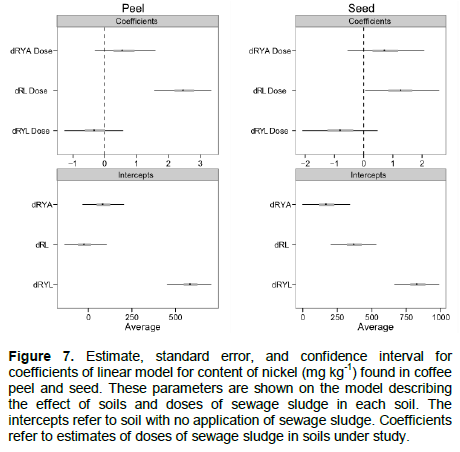
The amount of Ni found in coffee peel, obtained from coffee grown on dRL soil increased with application of sewage sludge (Figure 7). Concentrations of Ni obtained from this soil were around 0.4 and 0.6 mg kg-1, respectively for lesser and greater dose of sewage sludge (Table 4). Martins (2003), found similar amount of Ni in coffee seed, about 0.1 and 0.3 mg.kg-1, respectively from coffee grown on Dystrophic Red Latosol and Dystrophic Red Argisoil; with cumulative doses of sewage sludge, respectively about 29.8 and 18 Mg ha-1, dry basis.
The amount of Pb found in coffee peel was statistically different in the studied soils (F2,28 = 4.31 and p-value = 0.023), and did not differ in the coffee seed (F2,28 = 2.00 and p-value = 0.154). The content of Pb found in the coffee peel was not affected by doses of sewage sludge in each soil (F3,28 = 1.22 and p-value = 0.32), but it was affected in the coffee seed (F3,28 = 5.51 and p-value = 0.004). The content of Pb found in coffee seeds grown on dRL increased only with application of sewage sludge (Figure 8).
Estimates obtained for Cr in the coffee peel and seed are lesser than the detection limit of the equipment (2.13 µg kg-1). Martins (2003) also found lesser content of Cr in coffee fruits, about 3.5 µg kg-1 in the peel and 1.2 µg kg-1 in the grain. However, factors related with soil, plant, and sewage sludge exert control over the availability of Cr.
The sewage sludge increased the content of Cd, Cr, Cu, Pb and Zn found in studied soils, but their estimates were found to be less than those established for contamination prevention.
The sewage sludge decreased growth and productivity of coffee plants in studied soils. The sewage sludge increased the content of Cu, Zn and Cd found in coffee peel, as well as the content of Cd found in coffee seed in the studied soils. The sewage sludge increased the content of Zn and Pb found in coffee seed, for that grown on Dystropherric Red Latosol. Therefore, the content of trace elements found in coffee fruits are within allowed levels. So sewage sludge application to soils under coffee crops is able to increase trace elements in soils and decrease coffee productivity without any risk for human beings.
The authors have not declared any conflict of interests.
This study was funded by CAPES, CNPq, FAPEMIG, and INCT-CAFÉ. The Doctoral Scholarship was provided to the first author. The Opersan Environmental Services supplied the study sewage sludge.
REFERENCES
|
Berton RS, Nogueira TAR (2010). Uso de lodo de esgoto na agricultura. Cosine TAR; Nogueira, Pires AMM Uso agrícola de lodo de esgoto: avaliação após a resolução (375):31-50.
|
|
|
|
Bettiol W, Camargo OA (2001). Reciclagem de lodo de esgoto na agricultura. Biodegradação. Jaguariúna, Embrapa Meio Ambiente. pp. 93-113.
|
|
|
|
|
Bettiol W, Camargo OA (2006). A disposição de lodo de esgoto em solo agrícola. In: Lodo de esgoto: impactos ambientais na agricultura, eds. Bettiol W, Camargo OA, pp. 25-35. Jaguariúna: EMBRAPA Meio Ambiente.
|
|
|
|
|
Brasil (2006). Ministério do Meio Ambiente. Conselho Nacional do Meio Ambiente. Resolution nº 375, August 29, 2006. Set criteria and procedures for agricultural use of sewage sludge generated in sewage treatment station and products derived of the sewage sludge. Diário Oficial [da] República Federativa do Brasil 167:141-146.
|
|
|
|
|
Brasil (2009). Ministério do Meio Ambiente. Conselho Nacional de Meio Ambiente. Resolution nº 420, December 28, 2009. Define criteria and guiding values of soil quality for the presence of chemical substances and establishes guidelines for environmental management of areas contaminated by these substances resulted of human activities. Diário Oficial [da] República Federativa do Brasil 249:81-84.
|
|
|
|
|
Campos FS, Alves MC (2008). Uso de lodo de esgoto na reestruturação de solo degradado. Rev. Bras. Ciênc. Solo. 32:1389-1397.
Crossref
|
|
|
|
|
Catani RA, Pellegrino D, Bittencourt VC, Jacintho AO, Graner CAF (1967). A concentração e a quantidade de micronutrientes e de alumínio no cafeeiro, Coffea arabica, L., variedade mundo novo, aos dez anos de idade. Anais da Escola Superior de Agric. Luiz de Queiroz 24:97-106.
Crossref
|
|
|
|
|
Chang AC, Page AL, Warneke JE, Grgurevic E (1984). Sequential extraction of soil heavy metals following a sludge application. J. Environ. Qual. 13:33-38.
Crossref
|
|
|
|
|
Chen Z, Jiang X (2014). Microbiological safety of chicken litter or chicken litter-based organic fertilizers: a review. Agric. 4(1)1-29.
Crossref
|
|
|
|
|
Chiaradia JJ, Chiba MK, Andrade CA, Oliveira C, Lavorenti A (2009). Produtividade e nutrição de mamona cultivada em área de reforma de canavial tratada com lodo de esgoto. Rev. Bras. Ciênc. Solo 33:701-709.
Crossref
|
|
|
|
|
Donagema GK, Campos DVB, Calderano SB, Teixeira WG, Viana JHM (2011). Manual de métodos de análise de solo. 2. ed. Rio de Janeiro: EMBRAPA Solos.
|
|
|
|
|
Malavolta E, Graver EA, Sarruge JR, Gomes L (1963). Estudos sobre alimentação mineral do cafeeiro: XI., extração de macro e micronutrientes, na colheita, pelas variedades bourbon amarelo, caturra amarelo e mundo novo. Turrialba 13:188-189.
|
|
|
|
|
Martins DR (2003). Estado nutricional e qualidade de bebida em cafeeiros tratados com lodo de esgoto. Dissertation (Mester's degree in Agriculture Tropical e Subtropical) - Instituto Agronômico de Campinas, Campinas. 66p.
|
|
|
|
|
R Development Core Team (2014). R: a language and environment for statistical computing. Vienna: R Foundation for Statistical Computing.
|
|
|
|
|
Silva FC (2009). Manual de análises químicas de solos, plantas e fertilizantes. Brasília: EMBRAPA Informação Tecnológica.
|
|
|
|
|
Soares CRFS, Siqueira JO, Carvalho JG, Moreira FMS (2005). Fitotoxidez de cádmio para Eucalyptus maculata e Eucalyptus urophylla em solução nutritiva. Rev. Árvore 29:175-183.
Crossref
|
|
|
|
|
United States Environmental Protection Agency (1998). Method 3051 A, microwave assisted acid digestion of sediments sludge, soils and oils. In: SW-846: test methods for evaluation of solid waste: physical and chemical methods. 3rd ed. pp. 1-30, Washington: United States Environ. Prot. Agency. Available at:
View
|
|